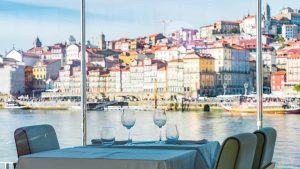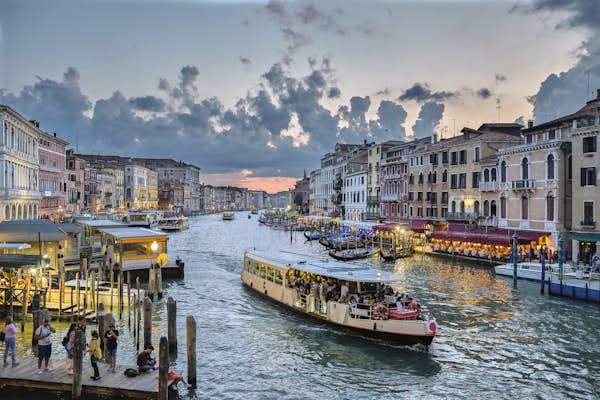
Venice has no equals in all of Europe. In this city floating on a lagoon, streets are canals and crossings are bridges.
Everything, from churches to palaces, speaks of more than a thousand years of history in which the Pearl of the Adriatic dominated the seas and grew wealthy on commerce.
On top of that, there are world-famous art exhibitions, romantic gondolas, and mouth-watering aperitivos. No wonder Venice regularly tops the list of Italy’s best places to visit. To help you plan your time in Venice, here are some of the city’s top things to do.
Discover the world’s most intriguing experiences with our weekly newsletter delivered straight to your inbox.
1. Ride a gondola or vaporetto
There are no cars or buses in Venice – to get around the city, you have to go on the water. Taking a ride in a gondola is not cheap – you’d be hard pressed to find a tour for less than €80 – but you are paying for an iconic Venice experience. Alternatively, get that water-level perspective of the city on a vaporetto ride, with a single ticket costing €7.50.
Planning Tip: If you expect to ride the vaporetto more than once, consider buying a day pass.
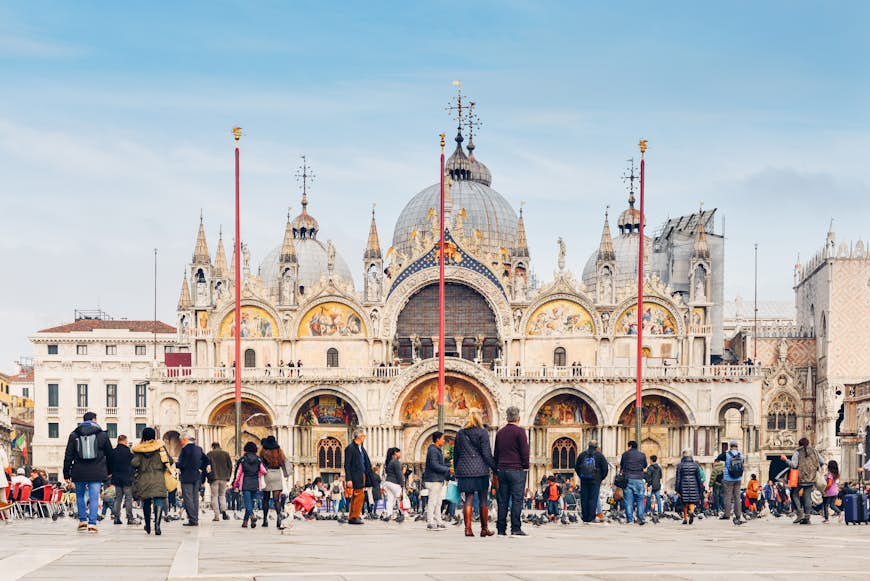 St. Mark’s Basilica is a remarkable building packed with treasures © Claudio Stocco / Shutterstock
St. Mark’s Basilica is a remarkable building packed with treasures © Claudio Stocco / Shutterstock
2. Wonder at the treasures in St Mark’s Basilica
Spend some time admiring Basilica di San Marco. Known as the “golden church” because of the priceless treasure it contains and immediately recognizable from its unique facade, the Basilica is a centuries-old testament to Venice’s power and long history. St Mark’s Square, surrounded by elegant buildings and leading directly onto the water, is equally iconic – as is the Campanile, one of the tallest in all of Italy.
3. Immerse yourself in art at the Biennale
As the name suggests, the Biennale exhibition of art happens once every two years, sprawling from the Giardini della Biennale (with its thirty pavilions, each belonging to a different country and hosting that country’s entries to the exhibition) to some of the rooms inside the Arsenale, which used to churn out the ships that guaranteed Venice’s dominion over the seas.
Planning Tip: It’s rightfully considered one of the most important events in the contemporary art world, but if your visit doesn’t coincide with one of the Biennale years, fear not, because you can still visit both the Giardini and the Arsenale.
 Carnevale usually takes place in February © Vigen M / Shutterstock
Carnevale usually takes place in February © Vigen M / Shutterstock
4. Join the euphoria of Carnevale
Venice is the Carnevale and the Carnevale is Venice. The city fills up with extravagant masks, colorful fabrics, and general euphoria. There’s no fixed date for Carnevale since it depends on Easter and Lent, but it usually happens in February. Despite the sometimes grey weather, it’s one of the best time to visit Venice.
Planning Tip: Find a spot in St Mark’s Square for one of the main Carnevale events, the Volo dell’Angelo, where a performer hangs on a zipline and swings down from the Campanile over the Square and the gathered crowd .
5. Relax on Venice’s beaches
It might not immediately come to mind but Venice is home to some beautiful beaches – the beaches on the isle of Pellestrina are easily reachable by ferry from the city and are the perfect location for a full immersion in nature.
Of course, the most famous beach of the Venice area remains the Lido with its chic glamor and its dolce vita vibe. If you plan your visit for the first days of September, you might be lucky enough to catch movie stars on their way to the Venice Film Festival.
6. Watch Venice race in the regattas
It shouldn’t come as a surprise that a canal-filled city is often the stage for animated regattas. The main one is the Regata Storica, which happens on the first Sunday of each September. Then there’s the Regata delle Antiche Repubbliche Marinare, which takes place in Venice every four years usually in June – Venice races against the other three old maritime republics, Genoa, Amalfi and Pisa. And in May, more than a thousand people join the Vogalonga, a sailing event open to professionals and amateurs alike. Seeing a regatta is a wonderful, free Venetian experience so it pays to try and time your visit to catch one.
Planning Tip: The republics take turns hosting the annual Regata delle Antiche Repubbliche Marinare, so you need to plan ahead to ensure your visit aligns with Venice’s celebration.
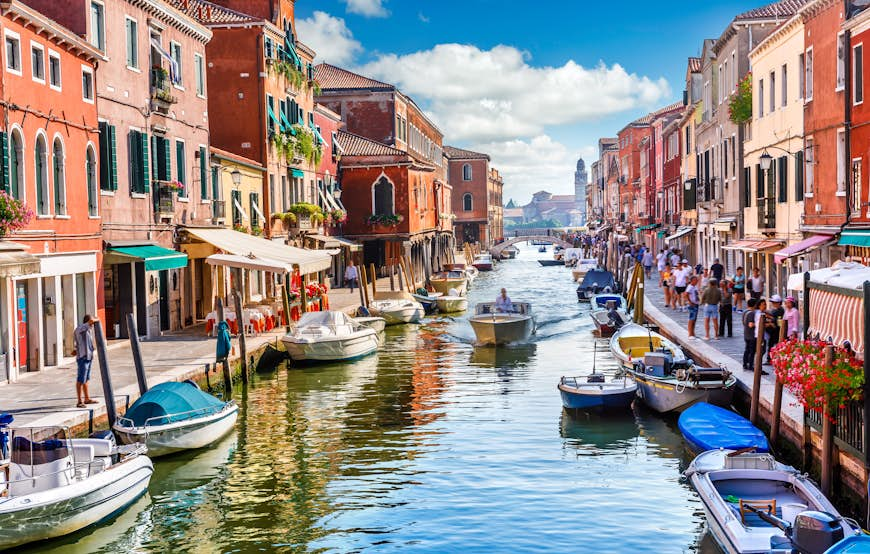 Learn about the local glass-making industry on Murano Island © Yasonya / Shutterstock
Learn about the local glass-making industry on Murano Island © Yasonya / Shutterstock
7. Visit Burano and Murano
Burano and Murano are two of the most famous islands of the lagoon, smaller cities within the city, and they’re definitely worth a visit if you can set aside one afternoon to take the vaporetto and reach them (it will take you around 40 minutes to get to Murano and an hour or so to Burano).
Both of them are known for their centuries-old artisanal traditions, which continue to be jewels in the crown of Venetian commerce. Take time to marvel at the master glassblowers bringing incredible creations to life on Murano and the intricately designed lace that has been the pride of Burano for centuries.
8. Drink in a bacaro
The bacaro is a typical Venetian bar where you can order a huge variety of wines and some tiny local snacks to accompany them – something that might remind you of Spanish tapas. People typically go to a bacaro for an aperitivo (a pre-meal drink), or as a way to start a night out, and your only challenge is deciding which one to pick from the many choices that dot Venice’s streets.
9. Shop local at Rialto Market
Venice’s most famous market is the one located around the central Rialto bridge. Divided into two sections, one dedicated to fruits and vegetables and the other to fish and seafood, the Rialto Market is both a tourist attraction and a staple of daily life for Venetians. The same area gets populated by myriad Christmas markets during the holidays.
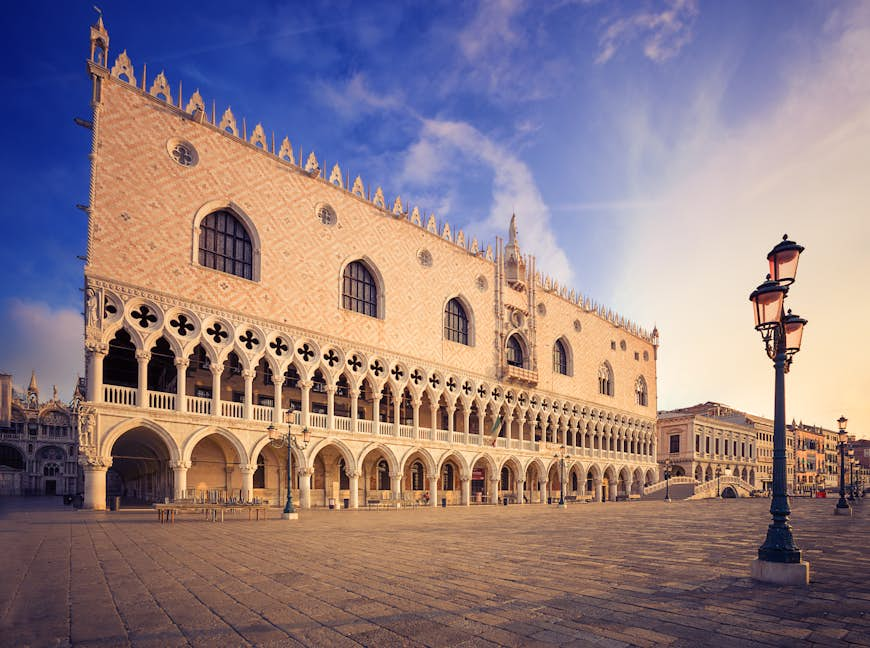 Visit the doge’s private apartments at Palazzo Ducale © Phant / Shutterstock
Visit the doge’s private apartments at Palazzo Ducale © Phant / Shutterstock
10. Tour the museums
Venice has no shortage of museums and treasures to amaze you with – you can wander the rich rooms of the Ducale Palace, the center of the Serenissima’s power, or the book-lined halls of the Marciana Library. If you prefer art to architecture, though, your only struggle will be to pick which collection you want to visit most – from the Renaissance and Neoclassical pieces of the Gallerie dell’Accademia or the modern art of the Ca’ Pesaro, Palazzo Grassi and the Peggy Guggenheim Collection. And for more insights into the history and culture of Venice, then you can check out Ca’ Rezzonico and Museo Correr.
11. Watch fireworks at Festa del Redentore
The Carnevale isn’t the only celebration animating the streets of Venice. On the third Sunday of July the city lights up for the Festa del Redentore, which commemorates the end of the plague that ravaged the city in the 16th century. The canals come to life with spectacular fireworks, which concentrate around the island of Giudecca.
Planning Tip: It’s a breathtaking spectacle wherever you are, but try to snag a viewing spot right on the waterfront for the ultimate experience.
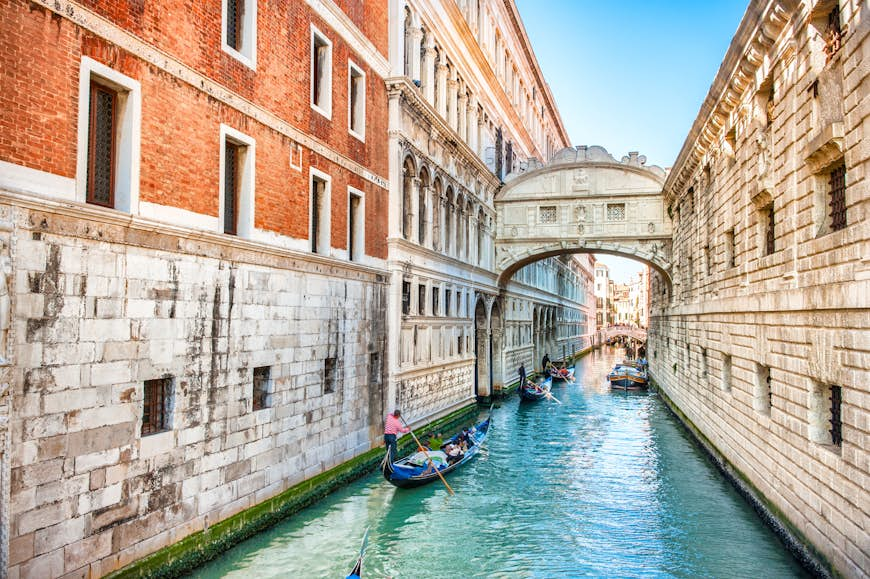 Prisoners got their last glimpse of Venice when they were led across the famous Bridge of Sighs © serenarossi / Shutterstock
Prisoners got their last glimpse of Venice when they were led across the famous Bridge of Sighs © serenarossi / Shutterstock
12. Admire the city’s famous bridges
Venice is filled with bridges and you’ll definitely stumble upon more than a few as you walk around, but there are a couple you need to seek out, like the Rialto Bridge towering over the Grand Canal, yet another of Venice’s world-famous symbols. Then there’s the Bridge of Sighs, just behind St Mark’s Basilica, where prisoners of the Serenissima sighed mourning their freedom as they were led into Venice’s fearsome prisons.
But you might also want to stray off the most-beaten path and seek out the Ponte del Chiodo. This is the only remaining bridge in Venice without a balustrade and a testament to the city’s past, when most bridges looked like this. While you explore on foot, try and check out some of Venice’s best – and lesser-known – neighborhoods.
13. Take in the views from the Libreria Acqua Alta
When high tides (acqua alta) cause parts of the city to flood, walkways are installed so that people can keep moving around. Strolling along these raised paths is a unique Venice experience, and you may catch this lagoon phenomenon if you’re there in autumn.
Either way, take some time to visit the bookshop that shares its name – the Libreria Acqua Alta is a joy for both eyes and Instagram feeds, with books stacked in bathtubs and gondolas to protect them from a possible flood, and a book staircase that allows you to reach a particularly beautiful belvedere over the canals.
 La Fenice theater is rich with history © Mats Silvan / Getty Images
La Fenice theater is rich with history © Mats Silvan / Getty Images
14. Watch a show at La Fenice
La Fenice, officially Gran Teatro La Fenice, is Venice’s main theater, rich with history as well as musical legacy. Not only has it been graced by many premieres from the great names of opera, like Verdi, Rossini and Donizetti, it has also played a symbolic and still crucial part in the Unification of Italy and in Venice’s struggle against Austrian domination.
Planning Tip: If you love classical music and opera, look into getting a ticket to one of the shows.
15. Go shopping
If you want to indulge in some retail therapy while you’re in Venice, you can head to Calle Larga XXII Marzo, the high-end street of the city, lined with luxury boutiques and flagship stores. Or you can choose the Fondaco dei Tedeschi, which used to be the palace-warehouse of German merchants during the days of the Serenissima and is now one of Venice’s main malls.
Planning Tip: The Fondaco has a beautiful terrace that everyone can access free of charge – you have to prebook your time slot as space on the terrace is limited, but the view over the Canal Grande makes it worth the effort.

